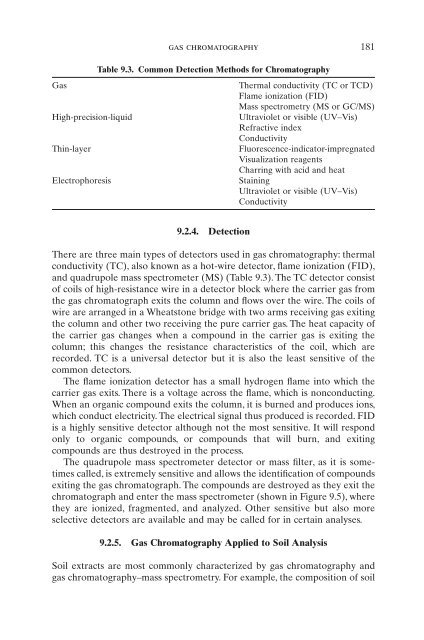Introduction to Soil Chemistry
Introduction to Soil Chemistry
Introduction to Soil Chemistry
You also want an ePaper? Increase the reach of your titles
YUMPU automatically turns print PDFs into web optimized ePapers that Google loves.
gas chroma<strong>to</strong>graphy 181<br />
Table 9.3. Common Detection Methods for Chroma<strong>to</strong>graphy<br />
Gas Thermal conductivity (TC or TCD)<br />
Flame ionization (FID)<br />
Mass spectrometry (MS or GC/MS)<br />
High-precision-liquid Ultraviolet or visible (UV–Vis)<br />
Refractive index<br />
Conductivity<br />
Thin-layer Fluorescence-indica<strong>to</strong>r-impregnated<br />
Visualization reagents<br />
Charring with acid and heat<br />
Electrophoresis Staining<br />
Ultraviolet or visible (UV–Vis)<br />
Conductivity<br />
9.2.4. Detection<br />
There are three main types of detec<strong>to</strong>rs used in gas chroma<strong>to</strong>graphy: thermal<br />
conductivity (TC), also known as a hot-wire detec<strong>to</strong>r, flame ionization (FID),<br />
and quadrupole mass spectrometer (MS) (Table 9.3). The TC detec<strong>to</strong>r consist<br />
of coils of high-resistance wire in a detec<strong>to</strong>r block where the carrier gas from<br />
the gas chroma<strong>to</strong>graph exits the column and flows over the wire. The coils of<br />
wire are arranged in a Wheats<strong>to</strong>ne bridge with two arms receiving gas exiting<br />
the column and other two receiving the pure carrier gas. The heat capacity of<br />
the carrier gas changes when a compound in the carrier gas is exiting the<br />
column; this changes the resistance characteristics of the coil, which are<br />
recorded. TC is a universal detec<strong>to</strong>r but it is also the least sensitive of the<br />
common detec<strong>to</strong>rs.<br />
The flame ionization detec<strong>to</strong>r has a small hydrogen flame in<strong>to</strong> which the<br />
carrier gas exits. There is a voltage across the flame, which is nonconducting.<br />
When an organic compound exits the column, it is burned and produces ions,<br />
which conduct electricity. The electrical signal thus produced is recorded. FID<br />
is a highly sensitive detec<strong>to</strong>r although not the most sensitive. It will respond<br />
only <strong>to</strong> organic compounds, or compounds that will burn, and exiting<br />
compounds are thus destroyed in the process.<br />
The quadrupole mass spectrometer detec<strong>to</strong>r or mass filter, as it is sometimes<br />
called, is extremely sensitive and allows the identification of compounds<br />
exiting the gas chroma<strong>to</strong>graph. The compounds are destroyed as they exit the<br />
chroma<strong>to</strong>graph and enter the mass spectrometer (shown in Figure 9.5), where<br />
they are ionized, fragmented, and analyzed. Other sensitive but also more<br />
selective detec<strong>to</strong>rs are available and may be called for in certain analyses.<br />
9.2.5. Gas Chroma<strong>to</strong>graphy Applied <strong>to</strong> <strong>Soil</strong> Analysis<br />
<strong>Soil</strong> extracts are most commonly characterized by gas chroma<strong>to</strong>graphy and<br />
gas chroma<strong>to</strong>graphy–mass spectrometry. For example, the composition of soil
















